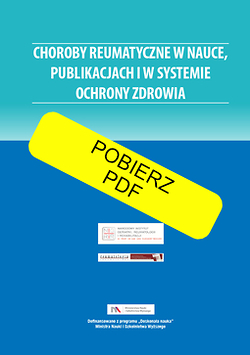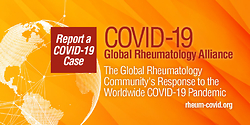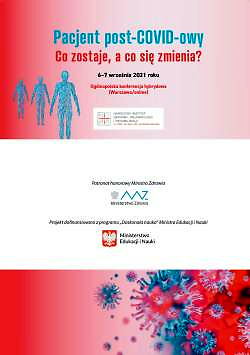|
6/2005
vol. 43
ARTYKUŁ ORYGINALNY/ORIGINAL PAPER
Ultrasonography, magnetic resonance imaging and conventional radiography of bone erosions in rheumatoid arthritis – a comparative study
Małgorzata Serafin-Król
,
Ru 2005; 43, 6: 301-309
Online publish date: 2005/12/22
Get citation
Introduction
Synovitis in rheumatoid arthritis (RA) leads to lesions of the articular surfaces of cartilage and bone. Such lesions may affect any synovial joint, yet they are most common in the peripheral joints. Radiological visualization of bone erosions in the hand and foot joints provides an important diagnostic criterion of RA [1-3] but the earliest erosions are detectable with conventional radiography (CR) only about 6 months after the onset of symptoms and after 12 months they are present in only about 30% of patients [3, 4]. This limits the usefulness of CR in the early stage of RA. At the same time, the high intensity of the inflammatory process, so characteristic of the early stage of the disease, requires a course of treatment to be introduced promptly in order to prevent the development or to inhibit the progression of irreversible bone damage. Modern imaging modalities, such as magnetic resonance imaging (MRI) and ultrasonography (US) have been proved to be more sensitive than CR in visualizing bone lesions in RA patients [5-12]. They enable bone structures (bone surfaces – in US) to be seen in many projections, images to be substantially magnified, and apart from that, they may improve the diagnosis by visualizing the inflammatory process in the surrounding soft tissue [6, 7, 10, 13-19]. Consequently, these modalities can be applied in the early diagnosis of RA. Because of the novelty of the problem and a small number of comparative studies it is not known if either of the modalities is superior, and therefore can be recommended in research and clinical practice. Reports comparing US and MRI in terms of the consistency of findings are discrepant and depend on the type of a joint studied and the investigation methodology [5, 6, 20]. The literature on MRI and US consistency in visualizing bone erosions in hand joints is scarce [6, 12, 21]. The aim of the study was the estimation of the agreement of MRI and US in visualizing bone erosions, and a comparison of these modalities with CR.
Materials and methods
The study included 50 RA patients diagnosed on the basis of the revised 1987 ACR criteria. The patients with hand deformations preventing the appropriate positioning for MRI scanning were excluded. The group included 33 women and 17 men, aged 23-75 years (mean age 53.0). The mean duration of the disease was 3.9 years (ranging from 2 months to 21.2 years). Table I shows clinical and laboratory findings. All patients underwent CR and US examinations of both hands, and MRI of the hand affected by a more severe inflammatory process as assessed clinically.
Hand radiographs were obtained in posteroanterior projection with exposure parameters 80 kV/63 mAs. The assessment included distal epiphyses of the ulnar and radial bones, wrist and metacarpal bones, and distal and proximal phalanxes. Radiograms were interpreted by an experienced radiologist (M.Z.). The patients were divided into two groups according to the results of the CR analysis: those with erosions and those without erosions. This simple division was chosen because of the strong discriminating value of the erosions in diagnosing of RA [2].
MRI scans of the hand with a more pronounced inflammatory process as detected on physical examination were performed with a 1.5 T Magnetom SP whole body system (Siemens). Spin echo sequences were obtained in T1-weighted images (repetition time, TR 600 ms, echo time, TE 15 ms) as well as images with fat saturation (A-250, TE 1122 ms, TE 22 ms). Scans were obtained before and after Gd-DTPA (Magnevist, Schering) administration (0.1 mmol/kg b.m.). Slices of 3 mm thickness were acquired in coronal projection with zero gaps. The extremity coil with the field of view of 21cm and the matrix of 256 x 512 were used. During the examination, the upper extremity was positioned along the body axis over the patient's head. In order to maintain the appropriate position of the joints, the hand was placed on a flat panel and immobilized with sand bags.
The MRI assessment included the number of joints with erosions seen as bone defects with sharp margins with a cortical break [22] filled with the tissue that enhanced after contrast administration (pannus) (Figures 1, 2a, 2b). The areas assessed were as follows: wrist (three levels: radiocarpal, intercarpal and carpometacarpal joints), metacarpophalangeal (MCP) joints, proximal interphalangeal (PIP) and distal interphalangeal (DIP) joints (17 joint regions in all). The examination lasted about 30 minutes. The findings were assessed by a radiologist experienced in MR evaluation of RA joints (R.A.).
The US examination of both hands was performed with a Sonoline Elegra (Siemens) unit with color Doppler (CD) and power Doppler (PD) options. A linear array 5-9 MHz transducer was used. The assessment included the estimation of the number of joints with bone erosions seen in two perpendicular projections as a discontinuity in the bone outline forming a pit with an irregular bottom and filled with hypoechogenic tissue (pannus) (Figures 3a, 3b). In cases of active disease pannus blood vessels infiltrating the erosions were seen in PD and CD US, making the assessment easier (Figures 4a, 4b). CD and PD US settings were the same for every patient and for all joints: pulse repetition frequency (PRF) of 868 Hz, low flow filter and gain just below the artifact level (about 70 dB). CD and PD US were used in a different part of the study, which is currently undergoing analysis. The observations that Doppler methods can improve visualization of the erosions are tentative and require more accurate assessment.
Similarly as in MRI, the US assessment included three regions in the wrist joint, MCP, PIP and DIP joints of both hands (34 joint regions in all) in all possible projections and aspects in the neutral position of the hand. Additionally, for better visualization of the joint surfaces an examination after moderate flexion of the joints was carried out. The duration of examining both hands was around 30 minutes. US findings were interpreted jointly by two investigators with experience in the analysis of musculoskeletal US findings (M.S-K., A.C.). The final result of the assessment was reached by consensus.
The study methodology was based on our own experience [7] and on the literature description of similar investigations [10]. All examinations in each patient were performed during one week, usually in the course of one day.
The findings obtained by different examination method were compared in the following way: CR findings were compared with US findings of both hands and with MRI findings of one hand. In comparison of US and MRI findings only one hand was considered.
Statistical analysis: The basic statistical methods were used to describe the group characteristics. In the analysis of MRI and US findings the contingency tables were used to determine the number of patients with a particular number of eroded joints. In order to evaluate the correlation between US and MRI, the significance test for Pearson correlation coefficient was used.
Results
Conventional radiography
No erosions were found in 34 patients (68%). The remaining 16 subjects (32%) had visible bone erosions.
MRI
MRI did not reveal any bone erosions in 19 patients (38%). In the remaining 31 patients (62%), erosions were found in 1-12 joints of the examined hand (mean 2.2±2.9).
US
US did not reveal any bone erosions in 16 patients (32%). In 34 subjects (68%), erosions were visible in 1-26 joints of both hands (mean 4.8±6.4).
Considering one hand also evaluated with MRI, no erosions were found in 17 patients (34%). The remaining 33 subjects (66%) presented bone changes in 1-13 joints (mean 2.6±3.7)
Comparison of CR and MRI
When radiological and MRI findings were compared, no bone erosions were found by either method in 19 patients. The remaining 15 patients (44.1%), who had no radiological bone erosions, presented erosions in MRI (Table II).
The ratio of detectability of erosions in MRI vs. CR was 31/16=1.9.
Comparison of CR and US
When radiological and US findings were compared, in 17 patients without erosion on CR, no bone erosions were found with US, either. The remaining 17 patients (50%), who had no radiologically detected bone erosions, presented erosions on US (Table III) (Figures 5a, 5b).
The ratio of detectability of erosions in US vs. CR was 34/16=2.1.
Early rheumatoid arthritis
A group of 15 patients with the disease duration shorter than 6 months was selected. In this group, no erosions in the hands were detected radiologically while US revealed erosions in 7 patients and MRI in 6 patients. The number of joints affected was 1-7 (mean 1.6±2.2) for both hands in US, and 1-4 (mean 0.8±1.1) for the hand also examined by MRI. The number of eroded joints revealed by MRI was 1-4 (mean 0.8±1.3).
Comparison of US and MRI
The correlation between US and MRI in visualizing bone erosions was found to be very high (coefficient of correlation =0.9; p<0.005) (Figures 6, 7a, 7b). The results are presented in Table IV. The interpretation of this table is as follows. If no erosions are seen in MRI, 68.4% of US findings also show no erosions. The remaining 31.6% of patients reveal 1-5 erosions. If, though, no US image shows erosions, 76.5% of MRI scans are also erosion-negative. One to two erosions are diagnosed in the remaining 23.5% of patients.
The findings for the 8 and more eroded joints are highly congruent. The highest discrepancy was observed for 1-2 and 3-4 eroded joints, but even here 60-70% of results are congruent.
Discussion
CR, US and MRI were compared for the assessment of the ability to show bone erosions in RA patients. The MRI protocol was selected in order to show accurately anatomical details of all joints of the hand in the shortest possible time. The sequences applied in this investigation followed the suggestions from previous studies and our own experience [10, 13]. Since the examination had to be made as brief as possible because of the articular pain, only the coronal projection was used, similarly to some earlier studies [13, 23]. In spite of that, the findings are consistent with those described in the literature when two perpendicular projections were applied [10, 11].
On US, each bone change was displayed in different planes so that potential mistakes due to natural bone roughness were excluded. A multiplanar US analysis is suggested also by other authors [9]. When in doubt, the assessed bone was compared with its contralateral counterpart. Ultrasound visualization of erosions was improved when color Doppler was applied. Where the vascularisation of the synovium was very extensive, the vessels infiltrating bone defects facilitate the localization of the erosions. So far this method has not been described as helpful in imaging bone erosions. The observations, as mentioned above, are preliminary and require further studies.
Both MRI and US showed more erosions than radiography in the hand joints, and this result is consistent with earlier reports [5-7, 9-12]. While radiography revealed erosions in 16 patients (32%), US showed them in 34 subjects (68%), and MRI in 31 (62%). Thus, in our study US depicted erosions 2.1 times, and MRI 1.9 times more frequent than CR in diagnosing arthritic bone erosions. Where in 15 patients (44.1%) CR revealed no changes, MRI showed erosions in 1-4 joints. US showed erosions in 1-9 joints of both hands (in 1-5 joints of the one hand) in 17 patients (50%) whose radiograms were erosion-free. Thus, both these imaging modalities allow to visualize diagnostically significant erosions in nearly half of the patients in whom CR failed to show any erosions. In 15 patients whose disease duration was 6 months or less from the onset of symptoms, radiography showed no changes whereas MRI revealed erosions in 6 patients (40%), and US in 7 (46.7%). These results concur with those reported before, though the study methodology varied in different papers [19, 24].
A high correlation between MRI and US was found in terms of showing the number of joints with bone erosions. Both these methods depicted erosions with similar frequency (agreement of over 70%). Backhaus et al. [6] reported different results - in her study, US was four times less accurate than MRI in revealing erosions in MCP, PIP, DIP joints in RA patients. This probably resulted from the technique of the examination. Backhaus et al. used a US 7.5 MHz transducer and examined the joints only in the neutral position from the dorsal and volar aspects. The erosions, however, are mainly encountered laterally, especially in PIP joints, as we found in our material. On the contrary, the MRI method was very accurate, employing 3D reconstruction of the joints examined, consequently obtaining better results than those of US. Wakefield [19], in his study on ultrasound imaging of MCP joints, reports that US turned out to be as sensitive as MRI, which resulted from the fact that the region examined was easily accessible for ultrasound penetration (MCP II at the radial approach). Alarcón [21] reported such a high agreement of US and MRI in imaging MCP joints in 10 RA patients that the authors suggested US should be used in clinical practice.
Despite the high correlation between US and MRI in revealing bone erosions, we find over 20% discrepancy between the methods. Yet, US showed more eroded joints. The discrepancy is most probably the result of the characteristic features of the two methods and of the study protocol used. As mentioned before, only one projection was used in MRI and all hand joints were visualized in a single sequence. US visualized structures in many planes and, what is more, the usage of high frequency transducer provided a high resolution of the image. The superiority of MRI results from its ability to show changes in regions inaccessible to ultrasound, regions hidden behind bone protrusions or on surfaces parallel to the ultrasound beam.
The US examination is cheaper and more available than MRI. The time necessary to examine one hand in MRI is sufficient for an ultrasound examination of two hands. Furthermore, a uniplanar MRI scan may lead to misinterpretation of the examined changes. Yet, while MRI allows to show the whole anatomy of the hand and to localize the changes precisely, US has only the bone outline as a point of reference. In order to interpret an image correctly, it is necessary to know perfectly the anatomy of the hand. Because of this, the reproducibility of lesion progression evaluation in this diagnostic modality may be rather poor. MRI also shows changes in regions inaccessible for ultrasound, beneath the bone cortex, including bone marrow edema believed to be a precursor of erosions [24]. Yet, performing this examination in the acute phase of the disease, when the joints are very painful, is sometimes impossible because it is difficult for a patient to remain motionless in an uncomfortable position.
In conclusion, ultrasonography and magnetic resonance imaging detects about two times more erosions in patients with rheumatoid arthritis than conventional radiography, that indicates the potential diagnostic value of these methods in patients with early stages of the disease. The high correlation between ultrasonography and magnetic resonance imaging in showing bone erosions proves that both these modalities can be applied interchangeably, depending on the preferences and possibilities of the research center.
Acknowledgements
This study was supported by The Polish Committee for Scientific Research, KBN, project number 4 PO5B 043 17 and 4 PO5B 031 16.
References
1. Arnett FC, Edworthy SM, Bloch DA, et al. The American Rheumatism Association 1987 revised criteria for the classification of rheumatoid arthritis. Arthritis Rheum 1988; 3: 315-24.
2. Devauchelle-Pensec V, Saraux A, Alapetite S, et al. Diagnostic value of radiographs of the hands and feet in early rheumatoid arthritis. Joint Bone Spine 2002; 69: 434-41.
3. Paimela L. The radiographic criterion in the 1987 revised criteria for rheumatoid arthritis. Reassessment in a prospective study of early disease. Arthritis Rheum 1992; 35: 255-8.
4. McQueen FM, Stewart N, Crabbe J, et al. Magnetic resonance imaging of the wrist in early rheumatoid arthritis reveals progression of erosions despite clinical improvement. Ann Rheum Dis 1999; 58: 156-63.
5. Alasaarela E, Suramo I, Tervonen O. Evaluation of humeral head erosions in rheumatoid arthritis: a comparison of ultrasonography, magnetic resonance imaging, computed tomography and plain radiography. Br J Rheumatol 1998; 37: 1152-6.
6. Backhaus M, Kamradt T, Sandrock D, et al. Arthritis of the finger joints: a comprehensive approach comparing conventional radiography, scintigraphy, ultrasound, and contrast-enhanced magnetic resonance imaging. Arthritis Rheum 1999; 42: 1232-45.
7. Ciechomska A, Andrysiak R, Serafin-Król M, et al. The assessment of the value of ultrasound and magnetic resonance imaging in diagnosing hand joint arthritis. Pol Merkuriusz Lek 2001; 11: 144-7.
8. Gilkeson G, Polisson R, Sinclair H, et al. Early detection of carpal erosions in patients with rheumatoid arthritis: a pilot study of magnetic resonance imaging. J Rheumatol. 1988 Sep;15(9):1361-6.
9. Grassi W, Filippucci E, Farina A, et al. Ultrasonography in the evaluation of bone erosions. Ann Rheum Dis 2001; 60: 98-103.
10. Klarlund M, Ostergaard M, Gideon P, et al. Wrist and finger joint MR imaging in rheumatoid arthritis. Acta Radiol 1999; 40: 400-9.
11. McQueen FM, Stewart N, Crabbe J, et al. Magnetic resonance imaging of the wrist in early rheumatoid arthritis reveals a high prevalence of erosions at four months after symptom onset. Ann Rheum Dis 1998; 57: 350-6.
12. Wakefield RJ, Gibbon WW, Conaghan PG, et al. The value of sonography in the detection of bone erosions in patients with rheumatoid arthritis: a comparison with conventional radiography. Arthritis Rheum 2000; 43: 2762-70.
13. Cimmino MA, Bountis C, Silvestri E, et al. An appraisal of magnetic resonance imaging of the wrist in rheumatoid arthritis. Semin Arthritis Rheum 2000; 30: 180-95.
14. Fornage BD. Soft-tissue changes in the hand in rheumatoid arthritis: evaluation with US. Radiology 1989; 173: 735-7.
15. Hau M, Schultz H, Tony HP, et al. Evaluation of pannus and vascularization of the metacarpophalangeal and proximal interphalangeal joints in rheumatoid arthritis by high-resolution ultrasound (multidimensional linear array). Arthritis Rheum 1999; 42: 2303-8.
16. Ostergaard M, Hansen M, Stoltenberg M, et al. Magnetic resonance imaging-determined synovial membrane volume as a marker of disease activity and a predictor of progressive joint destruction in the wrists of patients with rheumatoid arthritis. Arthritis Rheum 1999; 42: 918-29.
17. Sugimoto H, Takeda A, Hyodoh K. Early-stage rheumatoid arthritis: prospective study of the effectiveness of MR imaging for diagnosis. Radiology 2000; 216: 569-75.
18. Szkudlarek M, Court-Payen M, Strandberg C, et al. Power Doppler ultrasonography for assessment of synovitis in the metacarpophalangeal joints of patients with rheumatoid arthritis: a comparison with dynamic magnetic resonance imaging. Arthritis Rheum 2001; 44: 2018-23.
19. Weidekamm C, Köller M, Weber M, et al. Diagnostic value of high-resolution B-mode and doppler sonography for imaging of hand and finger joints in rheumatoid arthritis. Arthritis Rheum 2003; 48: 325-33.
20. El-Miedany YM, Housny IH, Mansour HM, et al. Ultrasound versus MRI in the evaluation of juvenile idiopathic arthritis of the knee. Joint Bone Spine 2001; 68: 222-30.
21. Alarcón GS, Lopez-Ben R, Moreland LW. High-resolution ultrasound for the study of target joints in rheumatoid arthritis. Arthritis Rheum 2002; 46: 1969-70.
22. Conaghan P, Edmonds J, Emery P, et al. Magnetic resonance imaging in rheumatoid arthritis: summary of OMERACT activities, current status, and plans. J Rheumatol 2001; 28: 1158-62.
23. McGonagle D, Conaghan P, O'Connor P, et al. The relationship between synovitis and bone changes in early untreated rheumatoid arthritis: a controlled magnetic resonance imaging study. Arthritis Rheum 1999; 42: 1706-11.
24. McQueen FM, Benton N, Crabbe J, et al. What is the fate of erosions in early rheumatoid arthritis? Tracking individual lesions using x rays and magnetic resonance imaging over the first two years of disease. Ann Rheum Dis 2001; 60: 859-68.
Copyright: © 2005 Narodowy Instytut Geriatrii, Reumatologii i Rehabilitacji w Warszawie. This is an Open Access article distributed under the terms of the Creative Commons Attribution-NonCommercial-ShareAlike 4.0 International (CC BY-NC-SA 4.0) License (http://creativecommons.org/licenses/by-nc-sa/4.0/), allowing third parties to copy and redistribute the material in any medium or format and to remix, transform, and build upon the material, provided the original work is properly cited and states its license.
|
|

 POLSKI
POLSKI












